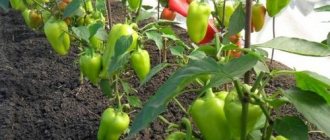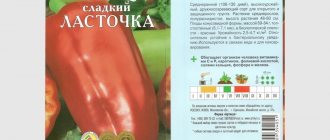When mentioning Moldovan pepper varieties, gardeners immediately remember Gift of Moldova and Gogoshary. With the first, everything is clear - sweet, salad, the same as Belozerka, only red, but although many have heard the name of the second, they don’t know what Gogoshar pepper is. Having bought it at the market and crumbled it into a salad, they are often surprised by the unusual taste, scolding the sellers - they slipped someone who knows what. More “advanced” ones blame farmers for allowing sweet peppers to be pollinated by bitter ones.
But first you need to figure out what Gogoshars are. The name unites a whole group of varieties, sometimes called Ratunda, sweet, spicy, with a slight bitterness.
Origin of the Gogoshary pepper variety
The Gogoshary sweet pepper variety was bred at the Moldavian Research Institute of Vegetable Growing during breeding work. Employees gave the new culture resistance to many diseases and pleasant taste.
Pepper has become widespread in Moldova, the western and southern parts of Ukraine, and northern Romania. It is often called ratunda pepper.
Gogoshary pepper seeds
Gogoshary pepper bush
Gogoshary pepper takes on the taste of neighboring vegetables
Description and characteristics
This is a very heat-loving plant. Can be planted in open ground in warm climates. In other regions of the country, only greenhouse cultivation is suitable. The temperature during cultivation should not be lower than +16 degrees. From the cold, the shoots freeze, the flowers and ovaries fall off.
The growing period is from 100 to 130 days. Productivity is good. When grown in a greenhouse with proper care, you can get up to 9 kg per square meter. m.
Description of the bushes
This variety of peppers has low and not spreading bushes, moderately branched. They can reach a height of 50 cm and a width of up to 45 cm.
It can be grown without the use of additional support. Experienced summer residents recommend placing pegs under the branches during a bountiful harvest so that they do not break off under the weight of the fruit. The branches are fragile, so additional support will not be superfluous.
Fruit characteristics
Gogoshary peppers have small flattened fruits, similar to pumpkins. Ribbed, have 4 chambers. The color can be red, yellow or orange.
The main advantages of the fruit:
- juicy dense pulp up to 1 cm thick;
- convenient weight from 50 to 140 g;
- the taste is sweet without bitterness;
- low calorie content;
- high content of vitamins;
- gradually ripen when collected.
The stalk of peppers is powerful and strong, so many of the fruits are directed upward.
Application
Housewives prefer Gogoshary peppers because of their unusual shape and thick, fleshy wall of the fruit. You can use the vegetable in first and second courses, bake it, prepare sauces with it, marinate it according to the classic version and with honey.
The small seed chamber does not make it possible to stuff peppers, but such recipes are also available. Gogoshars are stuffed not only with meat, but also with stewed apples, zucchini, onions and lemon.
Peppers of this variety can be stored fresh for a long time in a cool room. It is picked unripe, before the color changes from green to red or yellow. Gradually he will mature, the time will come to eat him. For storage, the fruits can be cut and frozen.
Gogoshary pepper is an easy variety to grow and use. For this reason, it is popular among summer residents; housewives are happy to purchase it.
Where to grow
The performance of the future harvest depends on the choice of planting site. For peppers, an important condition for growing is compliance with crop rotation. Due to the peculiarity of the Gogoshary variety, summer residents recommend choosing a place for sowing away from other types of this crop.
Location and lighting
For peppers, choose places that are well lit by the sun. The culture does not tolerate drafts, so it is not planted in elevated open areas.
Information! Seedlings need 12 hours of daylight to develop.
Soil for planting
The soil for planting is prepared several weeks before planting. It is mixed with nitrogen-containing fertilizers and spilled. In some regions where the air temperature is below +10 degrees, the soil is covered with film to create a greenhouse effect. This method helps warm the soil and give it the necessary structure.
Varieties
The variety has many varieties, which allows summer residents to choose the parameters at their discretion. Characteristics differ in color, appearance, ripening period, and fruit weight.
Ratunda
A classic representative of the variety. The color of the fruit is bright red, the shape resembles a small pumpkin, as it is flattened at the top and bottom. The taste of Ratunda pepper has a specific pungency, but there is no bitterness. The walls of the fruit are not thick, up to 0.5-07 cm, the average weight of peppers is up to 120 g.
Ruby
This variety can tolerate lower temperatures. The fruits are round with pronounced ribs. Color from dark red to brown. The walls of the fruit are juicy and fleshy, reaching a thickness of 1 cm. The average weight of peppers is up to 150 g.
Kolobok
The fruits are ball-shaped, up to 8 cm high, weighing about 150 g. They reach maturity 135 days after sowing. The pulp is dense, juicy, more than 1 cm.
The initial color is green; as the peppers ripen, they turn red. Productivity is average, up to 4 kg per 1 sq. m. The taste is sweet. Excellent for canning as it does not lose its shape when cooked.
Olenka
High-yielding variety. From 1 sq. m harvest up to 9 kg of peppers. Experts recommend growing this variety in a greenhouse. The color of the fruit changes as it ripens from green to burgundy; the pulp has a sweet taste with a pleasant aftertaste. It is successfully used fresh and canned.
Sweetie
The fruits are small, weighing up to 60 g. The original shape is wide at the top, with a pointed tip at the bottom. The pulp is sweet, the walls of the fruit are up to 7 mm thick. During cutting, a characteristic pleasant aroma is felt.
An early ripening variety, it takes 90 days to ripen. Increased resistance to diseases. With proper care, you can harvest up to 1.5 kg of vegetables from one bush. Peppers of this variety are often canned whole.
Fragrant golden anniversary
The fruits are round in shape with slightly pronounced ribs. The weight of one pepper exceeds 200 g. The pulp is sweet and juicy. At the growth stage, the fruit is green, but by the time it ripens it becomes yellow-orange.
Original Kolobok
The variety has small bushes, up to 40 cm in height. The fruits form early and are stored well in a cool room. The ripening period is 130 days. The fruits are smooth, weighing from 130 to 190 g. The pulp is juicy, dense, up to 6 mm thick. For 1 sq. m you can grow up to 10 kg of peppers of this variety.
Golden Tamara
Large fruits up to 220 g. The pulp is juicy, the wall thickness is more than 1 cm. Ripe peppers have a light green tint. The ripening speed is 135 days. High yield. From 1 sq. m you can collect 8 kg of vegetables.
Rich Ruby
It takes a long time to ripen up to 180 days. It has an unusual aroma and pleasant taste. A good harvest is obtained only in the southern regions. The weight of the fruit reaches 190 g, the thickness of the pulp is up to 1 cm.
Features of cultivation
To get a good harvest, you need to take into account all the subtleties of the variety when planning agricultural work. The main feature of Gogoshary peppers is considered to be easy pollination. To obtain a pure taste, you need to plant this variety away from other types of peppers.
Deadlines
The optimal growing time for each region will be different, depending on the climate. Gogoshary peppers are mid-season varieties; they should last about 90 days at home. Experienced vegetable growers recommend sowing seeds for seedlings 10-15 days earlier than other varieties of peppers. The best time to work is the end of February - the first days of March.
Seedlings should be transplanted into the ground when the soil warms up to +16 degrees. Dates are approximately from mid-May to June. You can plant seedlings in a greenhouse or open ground.
The readiness of seedlings can be determined by their appearance:
- the stem became dense and grew to 10 cm;
- 4 true leaves appeared;
- the root system is quite developed.
Under such conditions, the seedlings successfully adapt to a new location and take root well.
Land preparation
For seedlings, the soil must be fertile; the number of fruits and their taste depend on this. You can buy earthen mixture in the store, but it is better to prepare it yourself.
To do this, take meadow soil, cow manure compost, river sand in proportions 3:3:3. Manure and soil will ensure good fertility, and sand will provide reliable drainage. Mix the ingredients and pour into prepared containers.
Regular common containers are not suitable for Gogoshary peppers. Its root system is very sensitive and does not tolerate transplantation. If the roots are damaged, the plant stops growing. It’s better to take individual plastic pallets or pots made of peat crumbs.
Before planting seedlings, the soil is disinfected to get rid of bacteria. There are several ways to do this:
- steaming;
- potassium permanganate solution;
- roasting in the oven.
To steam, pour boiling water over the soil and let it cool. The solution of potassium permanganate should be used one day before sowing. Take a grain of potassium permanganate and dissolve it in warm water until you obtain a saturated solution. Pour it over the ground and let the water drain.
To calcinate, scatter the soil on a baking sheet no more than 10 cm high. Heat for 20 minutes at a temperature of +30 degrees. Cool the ground, you can sow the seeds.
Preparing and sowing seeds
Before planting, you need to calibrate and select good quality seeds. Take 1 liter of water, dissolve 1 large spoon of salt in it. Place pepper seeds in water and shake. Good, full-bodied seeds that will produce high-quality seedlings will fall down. Empty grains will remain floating. They are poured out with water, and those remaining at the bottom are used.
Seeds need to be treated before sowing. This procedure will get rid of pathogens and stimulate the physiological processes necessary for growth.
Algorithm for preparing Gogoshary pepper seeds:
- Place the seeds for 30 minutes in a weak solution of potassium permanganate.
- Place the seeds on paper towels for 10 minutes.
- Place 2 layers of cotton cloth or gauze in a saucer, pour water, and put pepper seeds there.
- After 2 days, the shell of the grains will crack and they can be planted in the ground. It is no longer possible to store such seeds.
- In the prepared soil, make grooves 2 cm deep with a pencil. Plant the seeds at a distance of 5 cm from each other, sprinkle with soil.
- Place containers with seedlings in a well-lit place, maintain the optimal temperature for growing from +24 to +26 degrees.
- Daylight hours can be extended if desired using a seedling lamp.
Experts do not recommend moving containers with seedlings to brighter places. It is better to create a greenhouse effect by placing glass on top or stretching film. When the first shoots appear, there is no need for a greenhouse.
Picking seedlings and care
For good root development and to prevent excessive stretching of the plant, it is necessary to pick. It is done after the appearance of 3 leaves. Carefully pry the sprout together with the earthen lump and move it to a previously prepared separate container with fertile soil.
After transplanting, young peppers may be drooping because the plant is under stress. To make it easier to get used to the new environment, place containers with seedlings in partial shade. In a week the normal state will be restored.
Watering
In the first month of growth, watering should be minimal. During this period, pepper seedlings are especially vulnerable to the fungal pathology “black leg”. This dangerous disease can destroy all sprouts within a day. The reasons are low temperature and waterlogged soil.
For seedlings, minimal watering at the root is sufficient. The best time would be early morning and evening. The water should be settled and warm. The leaves must remain dry. As the plant grows and gains green mass, the danger of this disease disappears; you can water more often, three times a week.
Transplanting seedlings into the ground
2 weeks before transplanting into open ground, seedlings need to be hardened off. To do this, take the containers with sprouts out into the fresh air for a while or open the windows. The amount of time for such procedures should increase daily.
When the temperature stays + 16 degrees day and night, the time for night frosts will pass, and it will be possible to plant seedlings in open ground. For 1 sq. m should accommodate no more than 5-6 plants. Make a distance of 60 cm between rows.
Temperature and lighting
Heat-loving peppers grow well at temperatures from +24 to +26 degrees. When these indicators decrease, plant growth slows down, flowers and ovaries may fall off.
Gogoshary peppers are very demanding on lighting. In sunny summers, their yield increases, and in cloudy weather it decreases. Vegetable growers do not recommend planting them in the shade of spreading trees.
How to care for Ratunda sweet peppers
We recommend reading our other articles
- How to grow an apricot from a seed
- Bronze broad-breasted turkey
- Melon Torpedo - variety description, cultivation and care
- Calf diseases and treatment
Water the Ratunda pepper in the evening with warm water directly under the root.
After planting the seedlings, you need to water the peppers and leave them to take root and take root for about a week. During this period, only watering is observed among the mandatory standards of care, because all other procedures can put the plants under even greater stress and negatively affect the development of the bushes. But when the plants take root, they are provided with complete care.
Water the Ratunda pepper in the evening with warm water directly under the root. It is worth making sure that the soil does not dry out, but it should not be swampy either. Usually, each bush uses up to 3 liters of water per watering, but if watering is frequent, then you can water it with a liter of warm water, this will be enough.
Interesting! To prevent plants from shedding formed ovaries, it is worth irrigating from time to time.
- Ratunda pepper grows up to 60 cm. This is not a very high height, but due to the heaviness of the fruits, they can bend to the ground and even break in strong winds, so a garter will not do any harm. The pegs are simply installed between the plants and the stems of the grown bushes are tied to them.
- Weeding in the case of sweet peppers can be harmful, because its root system forms a whole network in the upper layers of the earth. But to prevent the soil from drying out and becoming crusty, it is worth mulching it with straw or something similar.
- If the outside temperature does not drop below +35 degrees for a long time, the plants need to be darkened.
- Fertilizing with complex mineral fertilizers, compost or humus solutions will increase the yield by 1.5-2 times.
- Pests on peppers are not uncommon. For aphids, spider mites and some other insects, bushes are treated with insecticides such as Karbofos or Keltan. Sweet peppers rarely get sick, but if you do not follow the watering norm, rot may develop.
Caring for the Gogoshary pepper variety in open ground
Summer residents get high yields of peppers if they follow basic agrotechnical rules.
Watering and fertilizing
To obtain a rich harvest, peppers need not only watering, but also irrigation. Constant watering promotes the development of a strong root system, good plant growth, and fruit formation.
After transplanting into the ground, water the peppers every 10 days. Each plant needs to spend up to 3 liters of water. Irrigation methods: sprinkling and drip irrigation.
In hot weather, leaves lose moisture, reducing the flow of nutrients to them. They wither and dry up. Low air humidity and high air temperature provoke shedding of flowers and the end of fruiting.
Sprinkling can correct the situation. This increases the air humidity around the plant to 70%, the soil cools, the elasticity of the leaves is restored, and the activity of all life processes is resumed.
Twice during the summer the plants are fed with liquid fertilizers. The most effective feedings:
- on bird droppings;
- on nettles.
Bird droppings fertilizer
To prepare bird droppings fertilizer, take half a bucket of dry or liquid droppings. Add water and stir. Close the top well to prevent nitrogen from evaporating, and place in a sunny place. For better fermentation, stir the contents daily.
After a week, the feeding is ready. It needs to be diluted so as not to burn the roots of the plants. For 10 liters of water, take 0.5 liters of concentrated bird droppings fertilizer. After stirring, water at the root. For one bush you need 2 liters of fertilizer at a time.
Fertilizers for nettles
To make nettle fertilizer in a barrel, place the plant in half the volume of the container. Add water to the top, close the lid. Place in a sunny, windless place. To release carbon dioxide, stir the contents every day.
After 10 days, the fertilizer will be completely prepared. Immediately before use, it must be diluted with water in a ratio of 1:10. Each bush requires 2 liters of solution.
Liquid fertilizers are convenient to use in the country. They are easy to prepare yourself and can be used for a long time as needed.
Hilling and loosening the soil
After transplanting into open ground, plants need to be loosened periodically. This saturates the soil with oxygen and helps kill weeds. Loosening is carried out between rows; mulching is used for the root zone. The roots of this plant are too close to the surface and can be damaged when loosened.
The first weeding is carried out 2 weeks after planting in open ground, the second should be done after another 2 weeks. Hilling is carried out together with her. It is necessary for the formation of additional shoots at the roots. This increases the productivity of the plant. Further weeding is done if necessary. During loosening, it is important not to destroy the mound created during hilling.
Formation and care of bushes
As the pepper bush develops, growth and fruit set need to be regulated. The more ovaries form on the plant, the smaller the peppers will be in weight. If a summer resident wants to grow large fruits, then he needs to trim off the excess ovary. In the first half of August, it is recommended to cut off all the flowers from peppers, because the harvest from them will not have time to ripen before the onset of cold weather.
If in July the air temperature rises above 30 degrees, then the flowers of Gogoshary peppers will become sterile. Fruits will not form. To avoid this situation, cover the beds with plants with white agrofibre (spunbond). This will shade and cool the peppers.
Care after landing
Plants need to be looked after regularly. Make sure that the soil never dries out, as this will prevent it from getting rid of the inflorescences. Water the bushes at the root with water at room temperature. In order for moisture to be better absorbed, loosen the soil and water the paths between the bushes.
Loosening can be replaced with a more effective procedure - mulching. Use straw, sawdust or grass. Compact them in layers 3 cm high. Remove the shoots to form a bush.
Don't forget to weed the weeds. At the same time, tear the grass on the paths between the bushes, and not at the roots themselves. Feed the plant three times per season. Use nitrogen fertilizers at first, and then purchase phosphorus fertilizers.
When the first fruits appear, tie the plant up as it may break. Harvest carefully so as not to damage the stalk.
Harvest and storage
The first fruits ripen by mid-July. It is better to remove them so that they do not delay the ovary of the next peppers. It is better to store collected vegetables in a cool, dry place.
If you need to transport Gogoshary peppers over long distances, their ripening period is postponed for this purpose. In this case, remove the unripe green fruits and place them in cardboard boxes with holes for air movement. After a few weeks, the fruits will acquire yellow or red shades characteristic of the variety.
Photo
In order to better understand what Gogoshar is, you can look at the photographs below.
Advantages and disadvantages
Each variety has its own negative and positive qualities. The advantages can be noted as follows:
- compact bushes;
- excellent taste characteristics;
- neat shape of the fruit;
- high productivity;
- mid-season;
- wide application;
- resistance to diseases such as fusarium, rot, viral mosaic;
- ability to ripen when picked;
- suitability for storage and transportation
- low calorie content;
- easy care.
The variety has disadvantages:
- the need for regular fertilization;
- drought intolerance;
- inadmissibility of poor lighting;
- fragility of stems;
- exposure to pests.
Deficiencies can be corrected by proper plant care.
Reviews
★★★★★
Margarita, 37 years old, manager, Moscow region. The pepper came to us by chance, we were treated to it by friends.
We left a few seeds for planting; we really liked the taste and shape. It consistently gives a good harvest, is well stored - we are satisfied. ★★★★★
Tatyana, 43 years old, accountant, Chelyabinsk. This pepper is a favorite in our family.
I really like the Kolobok variety. Small, neat, juicy, and very convenient to prepare. It is not difficult to grow, it grows well in warm climates and produces a large harvest. ★★★★★
Stanislav, 67 years old, pensioner, Moscow. I have been growing Gogoshary peppers for more than 10 years.
The best variety of sweet pepper. Juicy, thick-walled, compact in shape. The whole family loves it and we recommend it to others too. Hide
Add your review
Gogoshary pepper is popular among gardeners due to its high yield, excellent taste and original appearance. Many beginners try to plant it on their plots. Complete information will be useful for proper care and obtaining a good harvest of vegetables.
0
0
Copy link











